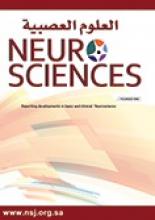Research ArticleOriginal Article
Open Access
Right-Sided clinical findings are worse prognostic factor in Multiple Sclerosis patients?
Asuman O. Varoglu and Ece Balkuv
Neurosciences Journal April 2020, 25 (2) 97-103; DOI: https://doi.org/10.17712/nsj.2020.2.20190111
Asuman O. Varoglu
From the Department of Neurology, Medical Faculty, Istanbul Medeniyet University, Istanbul, Turkey.
MDEce Balkuv
From the Department of Neurology, Medical Faculty, Istanbul Medeniyet University, Istanbul, Turkey.
MD
References
- ↵
- Al-Abdullah MS,
- Siddiqui AF
- ↵
- Fragomeni MO,
- Bichuetti DB,
- Oliveira EML
- ↵
- Frau J,
- Villar LM,
- Sardu C,
- Secci MA,
- Schirru L,
- Ferraro D,
- et al.
- ↵
- Novakova L,
- Axelsson M,
- Malmeström C,
- Imberg H,
- Elias O,
- Zetterberg H,
- et al.
- ↵
- Neveu PJ,
- Betancur C,
- Barnéoud P,
- Vitiello S,
- Le Moal M
- ↵
- Gontova IA,
- Abramov VV,
- Kozlov VA
- ↵
- Gontova IA,
- Abramov VV,
- Kozlov VA
- ↵
- Dane S,
- Borekci B,
- Kadanali S
- ↵
- Yoruk O,
- Karasen M,
- Timur H,
- Erdem T,
- Dane S,
- Tan U
- ↵
- Kramer MA,
- Albrecht S,
- Miller RA
- ↵
- Dane S,
- Erdem T,
- Gümüştekin K
- ↵
- Fu QL,
- Shen YQ,
- Gao MX,
- Dong J,
- Neveu PJ,
- Li KS
- ↵
- Nedeljkovic U,
- Dackovic J,
- Tepavcevic DK,
- Basuroski ID,
- Mesaros S,
- Pekmezovic T,
- et al.
- ↵
- Kurtzke JF
- ↵
- Roxburgh RH,
- Seaman SR,
- Masterman T,
- Hensiek AE,
- Sawcer SJ,
- Vukusic S
- ↵
- Cendrowski WS
- ↵
- Gerendai I,
- Halász B
- ↵
- Shen YQ,
- Hébert G,
- Moze E,
- Li KS,
- Neveu PJ
- ↵
- Algra A,
- Gates PC,
- Fox AJ,
- Hachinski V,
- Barnett HJ
- ↵
- Denarié N,
- Gariepy J,
- Chironi G,
- Massonneau M,
- Laskri F,
- Salomon J,
- et al.
- ↵
- Rodríguez Hernández SA,
- Kroon AA,
- vanBoxtel MP,
- Mess WH,
- Lodder J,
- Jolles J,
- et al.
- ↵
- Turnbull AV,
- Rivier CL
- ↵
- Renoux G,
- Bizière K,
- Renoux M,
- Guillaumin JM,
- Degenne DA
- ↵
- Bardos P,
- Degenne D,
- Lebranchu Y,
- Bizière K,
- Renoux G
- ↵
- Arrambide G,
- Rovira A,
- Sastre-Garriga J,
- Tur C,
- Castilló J,
- Río J
- ↵
- Tintore M,
- Otero-Romero S,
- Río J,
- Arrambide G,
- Pujal B,
- Tur C
- ↵
- Jetté N,
- Amoozegar F,
- Patten SB
- ↵
- Pauwels I,
- Cosemans L,
- Boonen S,
- Dubois B,
- Goris A
In this issue
Right-Sided clinical findings are worse prognostic factor in Multiple Sclerosis patients?
Asuman O. Varoglu, Ece Balkuv
Neurosciences Journal Apr 2020, 25 (2) 97-103; DOI: 10.17712/nsj.2020.2.20190111
Jump to section
Related Articles
- No related articles found.
Cited By...
- No citing articles found.





